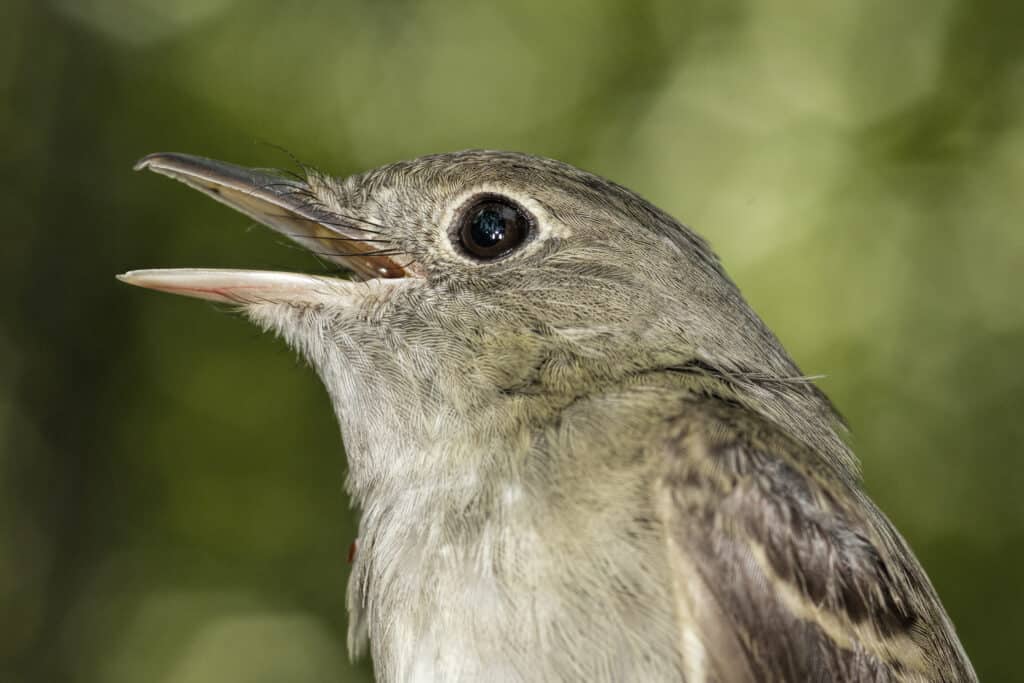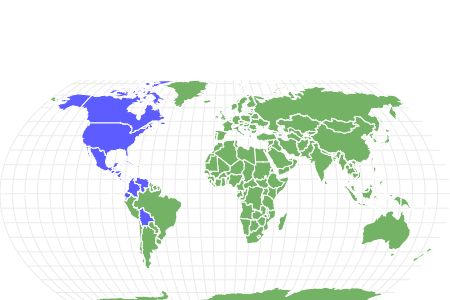Acadian Flycatcher
Empidonax virescens
Their nests are sloppily held together and have an abandoned appearance
Advertisement
Acadian Flycatcher Scientific Classification
- Kingdom
- Animalia
- Phylum
- Chordata
- Class
- Aves
- Order
- Passeriformes
- Family
- Tyrannidae
- Genus
- Empidonax
- Scientific Name
- Empidonax virescens
Read our Complete Guide to Classification of Animals.
Acadian Flycatcher Conservation Status
Acadian Flycatcher Facts
- Prey
- wasps, bees, caterpillars, ants, flies, beetles, moths, spiders, and millipedes
- Main Prey
- Insects
- Name Of Young
- Chicks
- Group Behavior
- Solitary/Pairs
- Fun Fact
- Their nests are sloppily held together and have an abandoned appearance
- Estimated Population Size
- 5.2 million
- Biggest Threat
- Habitat loss and degradation
- Most Distinctive Feature
- Olive green coloring with white wingbars
- Distinctive Feature
- Long tails and long wings
- Wingspan
- 8.7 to 9.1 inches
- Incubation Period
- 13 to 15 days
- Age Of Fledgling
- two weeks
- Habitat
- Wet deciduous forests
- Predators
- Birds of prey, snakes, cats, and rodents
- Diet
- Insectivore
- Lifestyle
- Diurnal
- Type
- Bird
- Common Name
- Acadian flycatcher
- Location
- North America, South America
- Nesting Location
- Fork of a tree hanging over water
- Migratory
- 1
View all of the Acadian Flycatcher images!
“Search for these birds in the mid-story of tall trees and look for quick movements as they sally out to catch insects.”
Summary
The Acadian flycatcher (Empidonax virescens) is a small passerine bird native to North and South America, where they inhabit wet riverside forests. They spend their days swiftly maneuvering through trees as they search for insects and small fruit. These solitary birds sing their songs early in the morning and defend their riverside nests with a monogamous partner. Discover all the fascinating Acadian flycatcher facts, including where they live, what they eat, and how they behave.
5 Amazing Acadian Flycatcher Facts
- Their nests are sloppily held together and have an abandoned appearance.
- Researchers first spotted them in present-day Nova Scotia (Acadia), but they no longer inhabit the area.
- They use rapid wingbeats to hover near foliage and snatch bugs.
- They build their nests in trees hanging over water as it’s easier to defend.
- Acadian flycatchers face future effects of climate change, like spring heat waves.
Where to Find the Acadian Flycatcher
Acadian flycatchers live in North and South America in over 15 countries, including the United States, Mexico, Venezuela, Colombia, and the Bahamas. Their range includes Southwestern Ontario and the Southeastern United States during spring and summer. They migrate through Mexico and Central America before reaching their wintering grounds in Northwestern South America. They breed in wet deciduous forests, such as swamps and dense riverside woods, and live in woodlands in their tropical winter homes. Search for these birds in the mid-story of tall trees and look for quick movements as they sally out to catch insects.
Acadian Flycatcher Nest
They nest in tall trees or large shrubs in horizontal forks away from the trunk. Females form a loose cup made from weed stems, twigs, and grass and lined with plant down. They may use spider webs to hold the material together, but the nest often has a sloppy appearance making it look abandoned.
Scientific Name
The Acadian flycatcher (Empidonax virescens) belongs to the Passeriformes order in the Tyrannidae family, which encompasses the tyrant flycatchers with over 400 species. The Empidonax genus includes small flycatchers, and the name is Ancient Greek for “gnat” and “master.” They were discovered in Acadia (present-day Nova Scotia), but they do not inhabit this area today.
Size, Appearance, & Behavior

Acadian flycatchers are small passerine birds, measuring 5.5 to 5.9 inches long and weighing 0.4 to 0.5 ounces, with an 8.7 to 9.1-inch wingspan.
©Bonnie Taylor Barrie/Shutterstock.com
Acadian flycatchers are small passerine birds, measuring 5.5 to 5.9 inches long and weighing 0.4 to 0.5 ounces, with an 8.7 to 9.1-inch wingspan. They have long tails, broad bills, large heads, and long wings. Adults are olive-green above and whitish below, with dark wings and white wingbars. Their bills are dark above and orange-yellow below.
These birds are mostly solitary, except during breeding, when they form monogamous pairs and nest near other flycatchers. They typically spend their time perched in the mid-canopy of their forest habitat, sallying out to catch insects and returning to their perch. They sing their songs early in the morning, an emphatic two-note “peet-seet!” The Acadian flycatcher is fun to watch as he quickly maneuvers through trees, using rapid wingbeats to take direct flights. Their exact speed is unknown.
Migration Pattern and Timing
Acadian flycatchers are long-distance migrants who begin their spring migration in early March and their fall migration in mid-September. They breed in the southeastern portion of the United States, from South Dakota down to Texas and east through New York and Florida. During migration, they travel along the Gulf Coast down to Mexico and through Central America before reaching their wintering grounds in Northern South America (Colombia and Venezuela).
Diet
Acadian flycatchers are primarily insectivores who forage by watching from a perch.
What Does the Acadian Flycatcher Eat?
Their diet consists of wasps, bees, caterpillars, ants, flies, beetles, moths, spiders, and millipedes. They also supplement their diet with some small fruits and berries. They select a perch from the mid-canopy, where they sit and watch before flying out to catch insects mid-air. This flycatcher will also snatch bugs from foliage while they hover.
Predators, Threats, and Conservation Status
The IUCN lists the Acadian flycatcher as LC or “least concern.” Due to its extensive range and extremely large, stable population, this species does not meet the “threatened” status thresholds. Their biggest threats include habitat loss and degradation from forest clearing as a result of agricultural and urban developments. They also face future climate threats, like spring heat waves, which can endanger nestlings.
What Eats the Acadian Flycatcher?
Their predators include crows, hawks, owls, jays, cuckoos, domestic cats, rat snakes, squirrels, chipmunks, and mice. Their young are more likely to fall prey, but parents build their nests in trees hanging over bodies of water because they are easier to defend. Males give rapid alarm calls to warn of intruders and may become aggressive if necessary.
Reproduction, Young, and Molting
Their breeding season falls between April and August, and they form monogamous long-term pair bonds, where they mate with one partner for many years. However, some males have been observed practicing polygamy and will mate with several females. Females lay two to four creamy white eggs and incubate them for 13 to 15 days. Their young fledge the nest when they can fly, around two weeks after hatching. The father feeds the fledglings while the mother begins incubating the second batch of eggs. They reach sexual maturity around one year and live an average of three years, but they can live up to 12.
Population
The global Acadian flycatcher population is estimated to number 5.2 million mature individuals. The species declined slowly from the 1970s to 2017, but recent trends suggest their numbers are stabilizing and possibly increasing slightly.
Related Animals:
View all 194 animals that start with AAcadian Flycatcher FAQs (Frequently Asked Questions)
Where are Acadian flycatchers found?
Acadian flycatchers live in North and South America in over 15 countries, including the United States, Mexico, Venezuela, Colombia, and the Bahamas. They breed in wet deciduous forests, such as swamps and dense riverside woods, and live in woodlands in their tropical winter homes.
How long do Acadian flycatchers live?
They live an average of three years but can reach up to 12.
How do I identify an Acadian flycatcher?
They have long tails, broad bills, large heads, and long wings. Adults are olive-green above and whitish below, with dark wings and white wingbars. Their bills are dark above and orange-yellow below.
How does the Acadian flycatcher eat?
They select a perch from the mid-canopy, where they sit and watch before flying out to catch insects mid-air. This flycatcher will also snatch bugs from foliage while they hover.
What does an Acadian flycatcher eat?
Their diet consists of wasps, bees, caterpillars, ants, flies, beetles, moths, spiders, and millipedes.
What threatens the Acadian flycatcher?
Their biggest threats include habitat loss and degradation from forest clearing as a result of agricultural and urban developments.
How big is an Acadian flycatcher?
Acadian flycatchers are small passerine birds, measuring 5.5 to 5.9 inches long and weighing 0.4 to 0.5 ounces, with an 8.7 to 9.1-inch wingspan.
Thank you for reading! Have some feedback for us? Contact the AZ Animals editorial team.
Sources
- Red List / BirdLife International, Available here: https://www.iucnredlist.org/species/22699842/138028636
- JSTOR / Bird-Banding, Available here: https://www.jstor.org/stable/4511309
- Government of Canada / Species at Risk Public Registry, Available here: https://web.archive.org/web/20170612221350/http://sararegistry.gc.ca/species/speciesDetails_e.cfm?sid=19

















